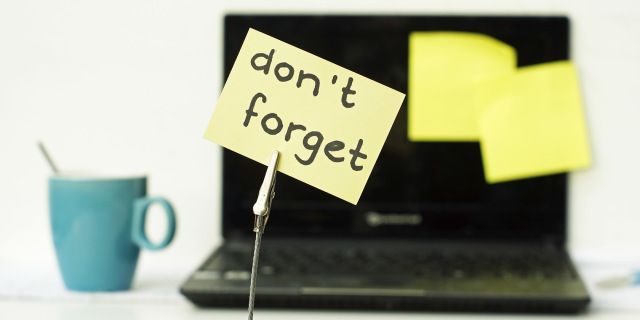We've all been there. The half-written to-do list stretching the length of your arm. The incessant notifications calling for our attention. The feeling of drowning in a list of never ending tasks -- from a computer waiting to be configured, to an unplayed game, to a terrifyingly busy inbox. The backlog, we fear, is here to stay. But here are 10 tips for clawing your way out of this predicament.
Mind Dump Your Tasks
The point of a mind dump is to achieve tabula rasa. A blank slate. A clean starting board that gives you the clarity to continue with less stress, and more productivity. In short, set some time aside (an hour or two should be plenty) to remove that mental backlog by pouring every task you can possibly think of into a Word document, a piece of paper, or a hefty pile of post-it notes. Be warned, the number of tasks will often be pretty damn depressing. I did this a few months ago, and the list was well over 200 items long.
Before dumping these tasks from your mind, you naturally receive daily/hourly/minute by minute reminders from your brain that add stress to your waking (and sleeping) life."Got to cut the lawn this evening!". "I promised Steve I'd call last week". "I still haven't fixed that lamp". "I need to clear that email backlog". Naturally, this is exhausting, and distracts you from the things you should be concentrating on. So, empty your mind, and write down every single thing you need to do, no matter how small. From here, you can begin to organise, rather than have that constant nagging voice at the back of your mind, and at last start to get things done!
Organise Your To Do List
I'm not one to advocate mind-dumping and writing lists under the bogus assumption that this is "productive" in itself, but by having a comprehensive to do list that's organised in a way that's helpful to you, you'll generally be in a position to start hammering through those items in a far more efficient way than simply going at them blind.
When it comes to organising a to-do list though, there's no correct way, but there are a number of options. It's up to you to decide which is best for you. You may want to split your list into personal, work, social etc. Each of these lists can be organised in different ways. Some of these are based on:
Context
Categorise your to-do items based on where and when these need to be done. For example, "Offline" items can be done when you're not able to connect to the Internet. "Leisure" items can be done when you're at home, instead of watching TV. "Town" items can be chores like going to the bank, picking up/returning items from various stores. "Work" items are, well, naturally done at work.
Save each of these lists into a reminder/list app that enables you to categorise, such as Trello or Apple Reminders, and access these wherever you are. So when you arrive home from work, you can simply check your "Leisure" list to see if there's anything you can work on without being reminded of the horrifying amount of tasks still left to be done at work.
Date Due
Organise your to do list from oldest items first to newest items last, so you can catch up with missed deadlines as soon as possible. Some items may not have a specific due-date but you could use an app such as Any.do to label these as due 'today', 'tomorrow', 'upcoming' or 'someday'.
Priority
Some items will have a higher priority than others. Therefore, tackling the highest priority first may be the best solution for you. By splitting tasks into "Urgent", "Somewhat Urgent", and "Non-Urgent" lists will help you choose which task to tackle first (i.e., often the hardest, most important task).
As a few higher priority items are completed and crossed off your list, you should feel far less stressed about the backlog.
Motivation
Organise your lists so that you have certain tasks that you know you can tackle when you're full or energy. Have another list for tasks to tackle when you're feeling lethargic after a tough day in the office, or a heavy night on the town. Often when people are feeling tired, they may avoid work at all costs, but if you know there are some tasks that can be completed without exerting much mental energy at all, you're more likely to turn to those instead of reverting to Netflix.
Remember to always keep these lists up to date. When a new task comes along, add it to the right label/list as soon as possible so you don't get that mental backlog building up once again.
Batch Process Similar Tasks
Moving from one task to an entirely different one takes its toll. Some even say multi-tasking can reduce your productivity by 40%. So, rather than constantly switching from one task to another in the vain hope that being "busy" is the same thing as being "productive", try batching similar tasks together to get them all out of the way in one swoop.
For example, read articles/blogs during an assigned time period, rather than throughout the day. Use tools like Instapaper to save articles to read later, and Digg Reader to keep up with your favourite blogs at a convenient time (say, during your commute). By organising your tasks like this (by context, as detailed above), you can get into 'the zone' and plough through similar tasks all at once and get that ultra-satisfying feeling of quickly scratching off a number of to-do items all at the same time.
Along a similar line, take up "Just in Time" learning, instead of "Just in Case" reading, to save you time now. This means saving useful articles using tools such as Evernote Web Clipper to read only when you need them rather than reading them just in case you'll need the knowledge in the future.
Remove Distractions
When focusing on your task backlog, remove as many distractions as you can. Tell your family not to disturb you for the next few hours. Turn off your phone. If that's not possible, at least turn it to silent mode, or disconnect it from the Internet. Many tasks will require your full attention. According to a Basex study, interruptions cost US businesses $588 billion per year, hinting at just how much time is wasted if you open yourself up to these distractions.
Abide By The Two-Minute Rule
When you have your complete to-do list in front of you, or are going through your inbox, try to stick to the 2-minute rule. Simply put, if it'll only take 2 minutes or less, do it now. Don't put it off. Don't sort it into a separate list. Do it now. When going through an inbox of 150+ unread emails, you'll be amazed at how many of these messages can be dealt with in two minutes or less. When you realise this, reaching Inbox Zero becomes far less daunting.
The 2-minute rule is also amazing for getting you into the right frame of mind to tackle a much larger task. If you have a tough report to write, convince yourself to spend just 2 minutes on the report. The inertia you'll often build up from these two minutes will be enough to keep you going for 30, 90, 120 minutes or even longer. If you're trying to master a level on a certain game, try just for two minutes. If you have a tough decision to make, grab a pen and paper, and brainstorm for just 2 minutes. This two minute promise to yourself is often enough to get you working and making progress on items that may have sat on your to do list, untouched, for months.
Declare Email Bankruptcy
If one of your major headaches is an incessantly overflowing inbox that's constantly full to the brim and shows no sign on easing up, you have two options. First, clean up your email subscriptions using a service such as Unroll.me. You can easily go through a lifetime of newsletter subscriptions and either unsubscribe, or add to a 'roll' (an aggregated, daily email) in a matter of minutes, in order to reduce the number of unnecessary emails landing in your inbox each day.
If this simply isn't enough, it may be time to declare email bankruptcy. Michael Hyatt says:
You know it’s time for email bankruptcy when:
- You have more than five hundred unread email messages in your inbox.
- Your colleagues are complaining about your lack of responsiveness.
- You have have had someone say more than once in the last week, "Did you get the email I sent to you? I haven’t heard back from you."
- You feel anxious or overwhelmed whenever you think about email.
From here, you can either go with the extreme option of selecting every single unread email (?-A on the Mac or Ctrl-A on the PC), or you can choose to use Michael Hyatt's approach and sort your emails by name, reply to a few important emails, but after 15-30 minutes, stop replying, select everything, and archive it all. Every. Single. Email.
The point here is, if anything is really important, you'll simply receive another reminder email about it. If it's not, you've saved yourself a ton of time. Enjoy the view of a completely empty inbox. It's a rare sight. From now on, aim to keep on top of these emails and never allow the email backlog to get to such extreme lengths again!
Abide By Your Natural Rhythms
We all have productive hours where we feel motivated, energised and ready to take on our toughest projects. We also have hours where we feel like anything but mindless TV will do. By learning about when these hours occur in our lives, we can organise our to-do list around them so that we can ensure that what needs to get done, gets done.
For a bit of a background, our bodies run on various Circadian and Ultradian rhythms. Circadian rhythms generally last around 24 hours (i.e. responds to daylight and night). Ultradian rhythms are much shorter, usually 90-120 minute brain wave cycles.
By learning about your own body's rhythms, you can take advantage of your natural "ups and downs". For example, when you feel a natural alertness come over you, that's likely the start of your ultradian rhythm. Take advantage of this, but keep an eye on the clock. When around 90 minutes or so is up, and you start to feel more drowsy, take a break. It's during this period you're most likely to procrastinate and make mistakes. To help you along with this, try out some of these Pomodoro apps to remind you when to take short breaks, and when to take long breaks.
Ernest Rossi says of this subject:
The basic idea is that every hour and a half or so you need to take a rest break – if you don’t you may be well on your way to the Ultradian Stress Syndrome: you get tired and lose your mental focus, you tend to make mistakes, get irritable and have accidents – If you continue to ignore your need to take a break you can experience more and more stress until you actually get sick.
In short, pay attention to your body's cycles, and don't push yourself too hard. It's often best to overcome a task backlog over a period of weeks rather than just a few days, as this can leave you burned-out and exhausted, thereby leading to yet another backlog building up as you try to recover.
Use Trello For A Kanban Workflow
Personally, I love Trello for task management, especially using the platform for a Kanban workflow. Trello is a free system where you can set up boards, which each contain cards. Each of these cards is an item on your to do list. To set this up as a Kanban system (which is pretty popular with Toyota), simply start with three vertical lists labelled (from left to right), "Backlog", "In Process", and "Completed" (you can of course add more, in the correct order, such as "Test", "Review", depending on the situation). You can read a more detailed explanation of the Kanban Trello workflow here, but the basic aim is to work on moving each item from the left (backlog) to the right (completed). Once an item reaches the right-most stream, you know it's completed, and you can archive this item.
This approach not only helps you to see what needs working on, what is currently being worked on, and what's been done, but it adds a bit of a "gamification" element to your task backlog, and keeps you motivated as that "backlog" list gets smaller and smaller. Oh, and you can also use this approach to help you keep in touch with everyone you know.
Use Decision Trees For Easier Decision Making
We can often spend way too long with decisions. Decision Trees can be used to help make this process easier and more efficient so you can rapidly move on from the decision making process, and get on with more important things. Watch this video for an interesting introduction:
Public Accountability
By publicly announcing your goal to, say, "get to Inbox Zero by 6pm", or "Complete my most important 2 tasks by 2pm", you're far more likely to succeed. Whether you text a friend, publish a Facebook post, tweet, or use an app such as Lift where other users can give you props for achieving a daily habit, that added level of accountability will motivate you to succeed.
How To Keep Your Backlog Manageable
Once you've managed to get your backlog under control, be careful to keep it that way. A few pointers (other than maintaining the suggestions above) are:
- Keep you to-do lists up to date. Make sure you can rely on them, so your mind can be clear to simply get on with the tasks at hand.
- Live by your calendar. Learn to rely on your calendar, and treat it as sacred. If something is scheduled it must get done, else the backlog simply grows. And grows. And grows.
- Build in Regular Reviews. Review your tasks every day, week or month. Remove anything that's not needed, and add anything that's missing. Know what needs to be done, and by when.
- Learn to say No. To keep your backlog under control, you need to learn to say "no" more often. A great book to read for a fuller understanding of this is Essentialism: The Disciplined Pursuit of Less, by Greg McKeown
We all know what's it's like to feel like you're drowning in a sea of task, but I hope these suggestions can help you to use some different approaches to tackle that growing list head on, and to keep it under control!
What other strategies and tactics have you used to efficiently move through your task backlog? Please let me know in the comments!









